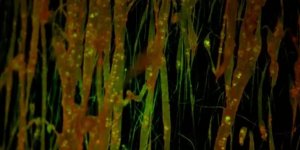| News / Tech News |
Displays controlled by flexible fins and liquid droplets more versatile, efficient than LED screens
Flexible displays that can change color, convey information and even send veiled messages via infrared radiation are now possible, thanks to new research from the University of Illinois Urbana-Champaign.

Engineers have developed a new breed of display screens that use flexible fins, varying temperatures and liquid droplets. Photo: Sameh Tawfick
Engineers inspired by the morphing skins of animals like chameleons and octopuses have developed capillary-controlled robotic flapping fins to create switchable optical and infrared light multipixel displays that are 1,000 times more energy efficient than light-emitting devices.
The new study led by Sameh Tawfick, a mechanical engineer at the University of Illinois, demonstrates that bendable fins and fluids can simultaneously switch between straight or bent and hot and cold by controlling the volume and temperature of tiny fluid-filled pixels.
Varying the volume of fluids within the pixels can change the directions in which the flaps flip — similar to old-fashioned flip clocks — and varying the temperature allows the pixels to communicate via infrared energy.
"An everyday example of elasto-capillarity is what happens to our hair when we get in the shower," Tawfick said. "When our hair gets wet, it sticks together and bends or bundles as capillary forces are applied and released when it dries out."
In the lab, the team created small boxes, or pixels, a few millimeters in size, that contain fins made of a flexible polymer that bend when the pixels are filled with fluid and drained using a system of tiny pumps. The pixels can have single or multiple fins and are arranged into arrays that form a display to convey information, Tawfick said.
"We are not limited to cubic pixel boxes," Tawfick said. "The fins can be arranged in various orientations to create different images, even along curved surfaces. The control is precise enough to achieve complex motions, like simulating the opening of a flower bloom."
The study reports that another feature of the new displays is the ability to send two simultaneous signals — one that can be seen with the human eye and another that can only be seen with an infrared camera.
"Because we can control the temperature of these individual droplets, we can display messages that can only be seen using an infrared device," Tawfick said, "Or we can send two different messages at the same time."
The team said that because the science behind gravity's effect on droplets is well understood, it will provide the focal point for their next application of the emerging technology. (U.S. National Science Foundation)
YOU MAY ALSO LIKE





